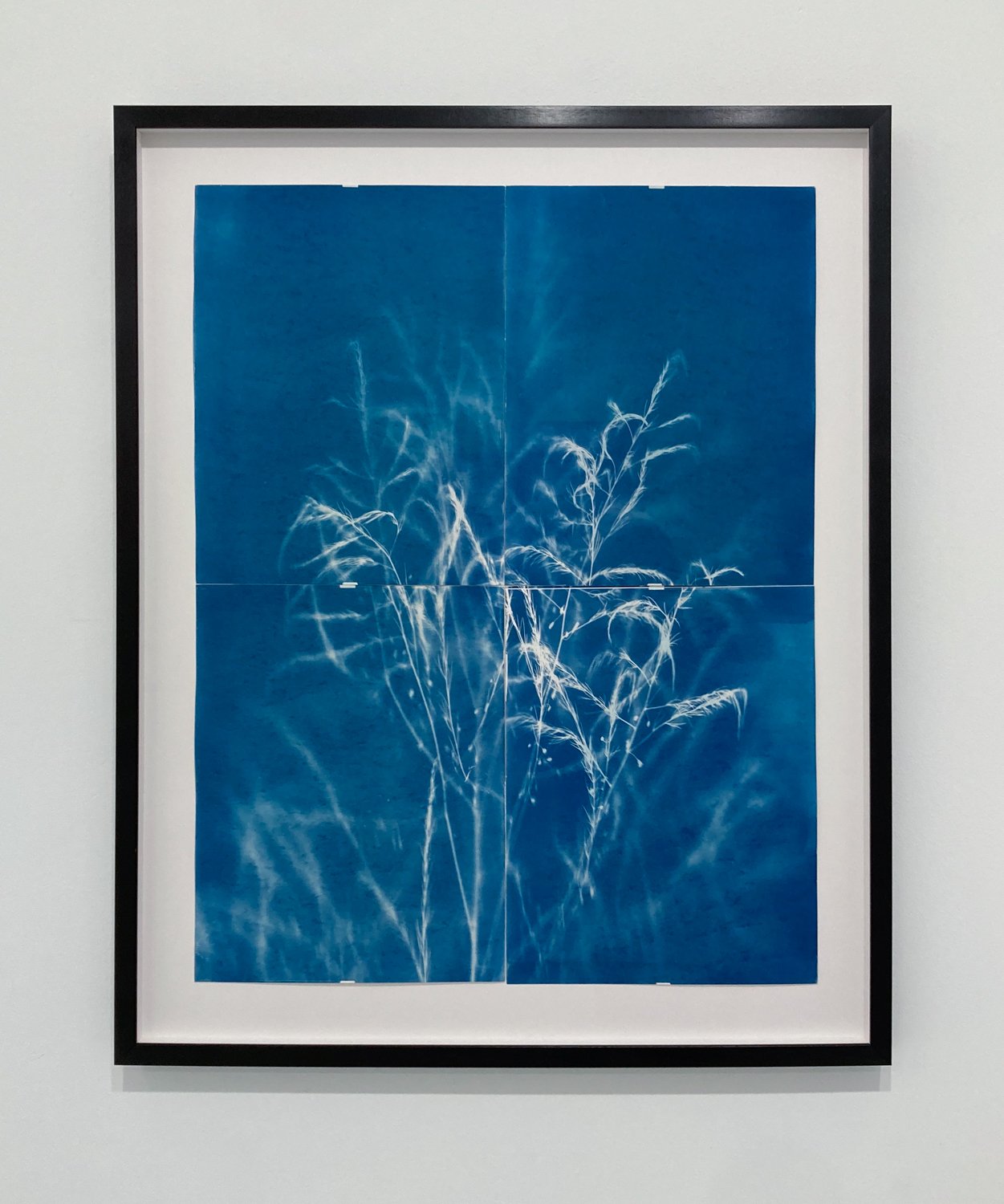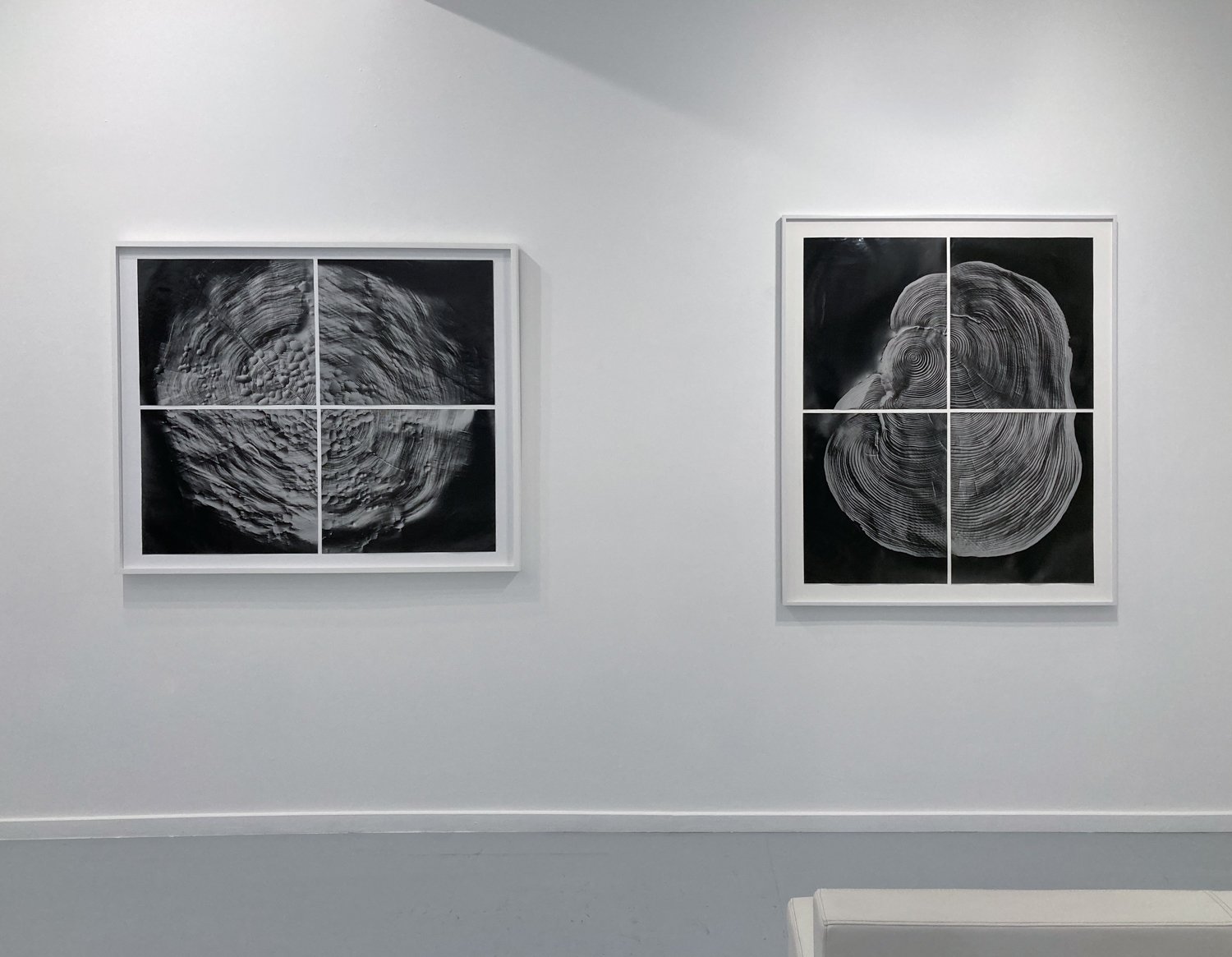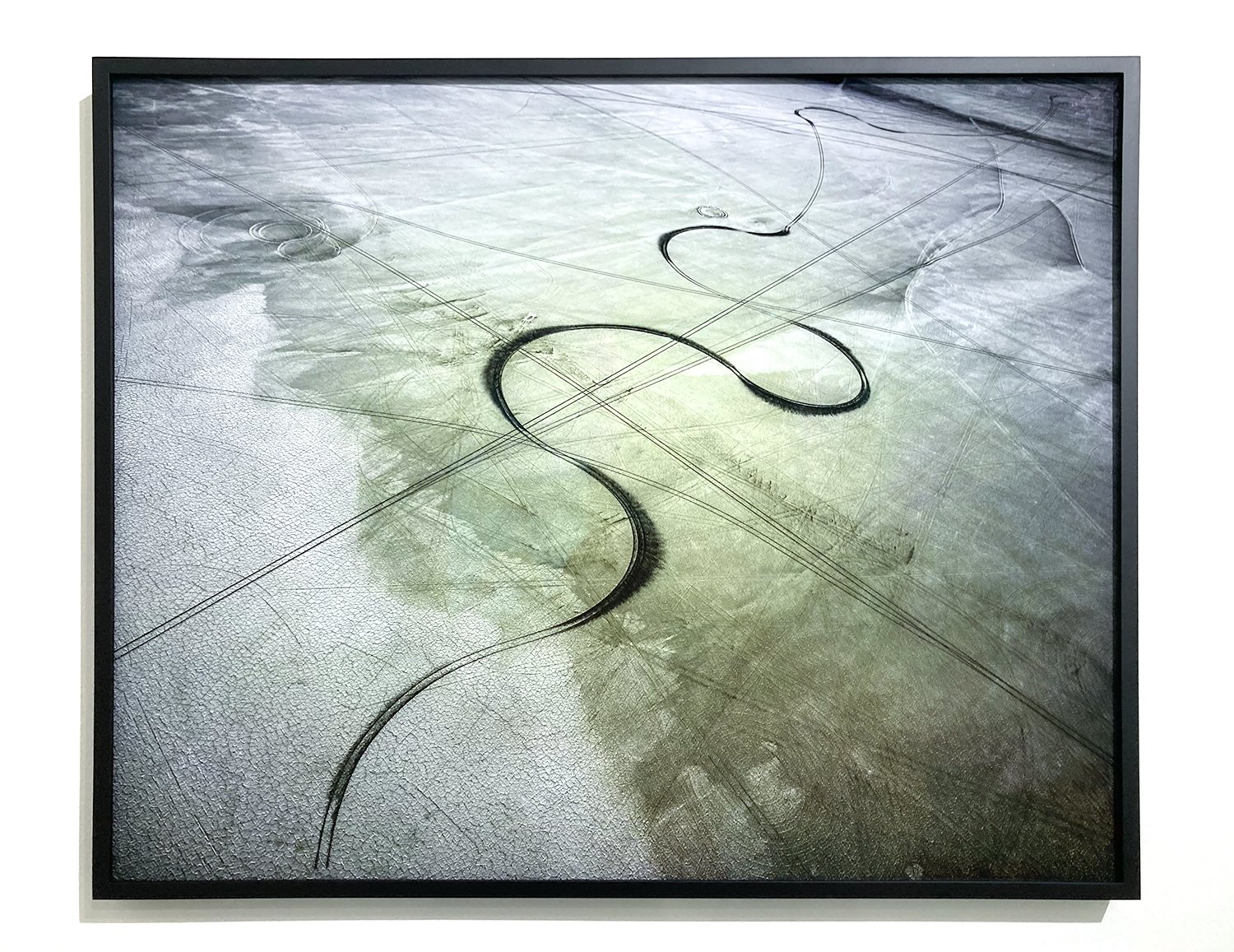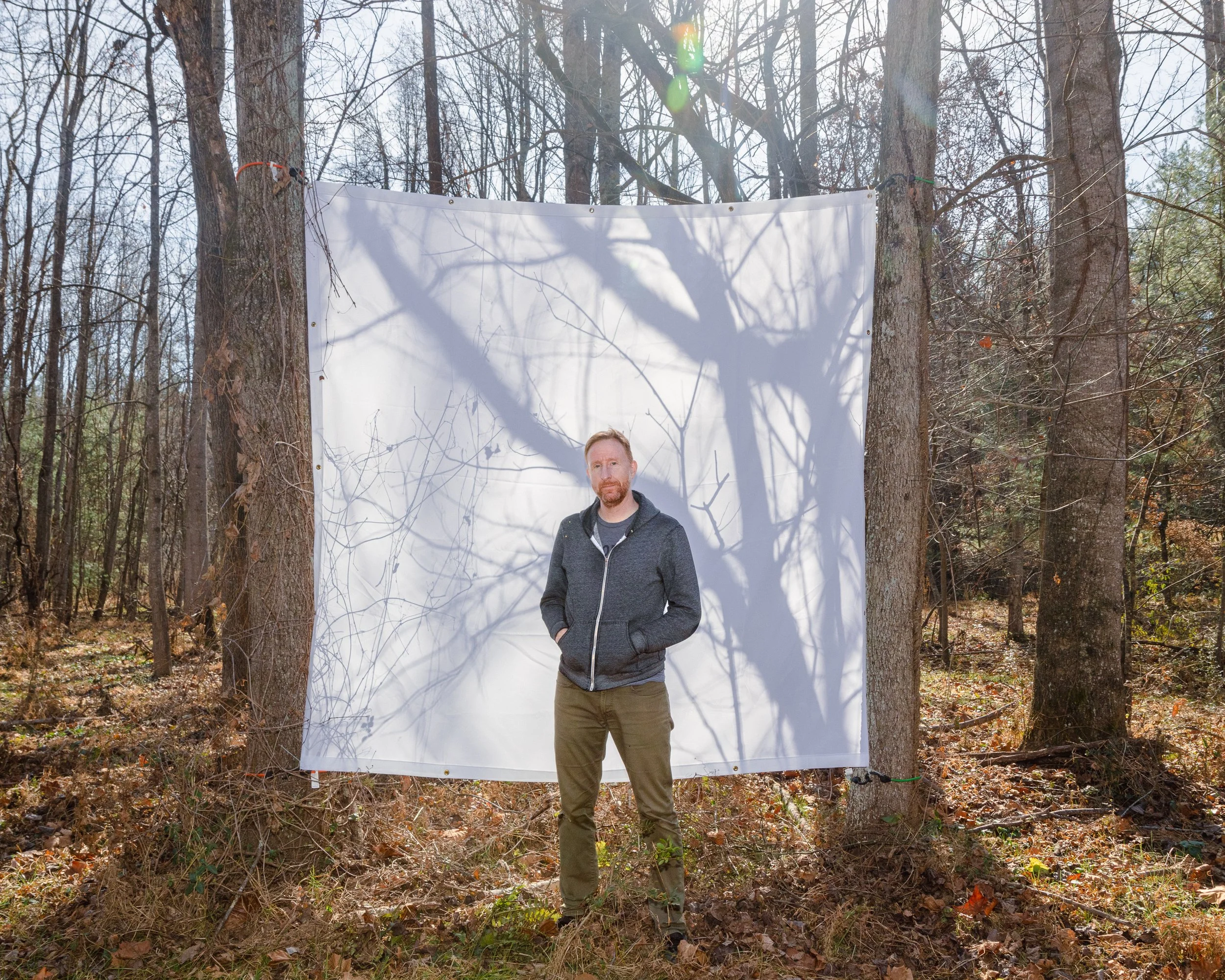Details of artworks: top left: Ansley West Rivers, North Bay Map (Bodega Bay to San Joaquin River), 2019; top right: Klea McKenna, Born in 1934 (1), 2019; middle left: Michael Light, Edge Of Carson Lake Looking East, Pleistocene Lake Lahontan, Fallon, Nevada, 2018; bottom left: Eric William Carroll, Asparagus, 10/27/21 (B), 2021; bottom right: Julia Goodman, Two (Promise), 2021
Grid, a group exhibition
February 4 - March 25, 2023
Opening Reception: Saturday, February 4, 4-6 pm
Eric William Carroll
Julia Goodman
Michael Light
Klea McKenna
Ansley West Rivers
EUQINOM Gallery is pleased to present Grid, a group exhibition exploring the visual structure of the grid as a tool for art making. Using a range of materials and approaches, each of the artists uses grids to create a framework for mapping and understanding the world around them from a unique perspective.
Download Press Release
E R I C W I L L I A M C A R R O L L
In Arrays, Carroll employs a modular format to construct multi-panel cyanotypes of plant species growing in and around his North Carolina home. Created by placing light-sensitive paper in close proximity to the subject and exposing it to direct sunlight for 10-30 minutes, the resulting images are the visual equivalent of a field recording; abstract yet documentary, ephemeral yet firmly rooted in a specific time and place. The longer exposures imbue each work with a certain softness that is contrasted by the grid arrangement, which references Robert Smithson’s “Mirror Displacements” and Henry Fox Talbot’s process for making multiples. Carroll's goal for this series is to create ongoing portraits of these particular plants that he interacts with on a daily basis--a visual way to measure and record life and its inevitable end.
J U L I A G O O D M A N
Two (Promise) is composed of two separate paper forms cast from the same brick wall. The front side of each piece subtly gradates between blue and black in opposite directions. The two overlapping panels are suspended inches away from both each other and the wall. The radiant verso of the forms casts a saturated green glow on the wall behind. The two pieces are the heights of the artist and her partner, and include blue and black fabrics from their home. The brick’s patterned texture is interrupted by inclusions of torn fabric and threads both embedded in the pulp and removed to leave an impression across the surface. Two (Promise) alludes to the intense pressure put on relationships when domestic spaces and outside worlds collide.
M I C H A E L L I G H T
In Lake Lahontan | Lake Bonneville, Michael Light continues to examine ideas of perceptual orientation, mapping, and human impact on the land. Twelve thousand years ago, these vast bodies of water covered most of the Great Basin. Documenting the landscape of these largely evaporated lakes, Lake Lahontan | Lake Bonneville offers an elegiac and forceful look at the politics of erasure. The aerial photographs are abstract and painterly investigations that reveal hitherto unseen terrain imprinted by both human intervention and geological phenomena.
K L E A M c K E N N A
Automatic Earth refers to what Klea McKenna sees as a “blueprint” within nature; a plan within each organism to automatically generate a particular form or pattern that is, in its execution, almost inevitably flawed. She approaches these broken patterns within the landscape as allegories for the human emotional experience. It’s where the pattern breaks that we’re told something: a draught, a trauma, an interaction, the slash of a chainsaw... a crack in the earth. Trees grow for decades or centuries and their formation is a record of time, labor, and the story of a life. The process of making her work provides an unlikely prescription for how to experience the landscape, and how to generate evidence of that experience. With a variety of raw, even crude methods, McKenna records the imprint of these organic patterns into embossed photograms she calls “photographic rubbings.”
A N S L E Y W E S T R I V E R S
The topographical cyanotypes in Ansley West River’s Seven Rivers map the Bay Area’s tributary systems, illustrating a personal journey down each waterway based on the maps found at parks, gas stations, and local bookstores. The cyanotype paintings show the shape and movement of the river across the landscape. Overlaid with maps and journal entries printed in palladium and Van Dyke, this multilayered work depicts both the artist’s relationship to the rivers and the present-day surveys which emphasize the dams, reservoirs, industry, and tributaries of each watershed. The maps act as blueprints to the American landscape as the blue water pulses through the brown tones of the earth.
I N S T A L L A T I O N V I E W S





W O R K S
A B O U T T H E A R T I S T S
Eric William Carroll’s work has been shown widely and has been included in exhibitions at the New Orleans Museum of Art, New Orleans, LA; Aperture Foundation; the Museum of Contemporary Photography, Chicago, IL; Pier 24 Photography, San Francisco, CA; Walker Art Center, Minneapolis, MN among others. Carroll has participated in residencies with the MacDowell Colony, Rayko Photo Center, and the Blacklock Nature Sanctuary, and was awarded the 2012 Baum Award for Emerging Photographers. Born and raised in the Midwest, Carroll is currently based in Asheville, North Carolina.
Julia Goodman (b. 1979, Atlanta, GA) earned an MFA from California College of the Arts (2009) and a BA in International Relations and Peace & Justice Studies from Tufts University (2001). She studied art at Santa Monica College (2002-2006). Recent exhibitions include the National Museum of Women in the Arts, Washington D.C.; Contemporary Jewish Museum, San Francisco, CA; San Jose Museum of Art, San Jose, CA; DePaul Art Museum, Chicago, IL; Berkeley Art Center, Berkeley, CA; Poetry Foundation, Chicago, IL; Salina Art Center, Salina, KS; Saint Mary’s College, Notre Dame, IN; and California College of the Arts Hubbell Street Gallery, San Francisco, CA. Her residencies include JB Blunk Residency, Inverness, CA; Recology SF, San Francisco, CA; Creativity Explored, San Francisco, CA; and Salina Art Center, Salina, KS. Goodman lives and works in Berkeley with artist Michael Hall and their young child. ed by Steidl with a multi-dimensional debut exhibition at The Arts, Design & Architecture Museum in 2022.
Michael Light (b. 1963) is a Bay Area photographer, bookmaker, and pilot. He has exhibited globally including solo exhibitions at the San Francisco Museum of Modern Art, The Nevada Museum of Art, Reno, the Chrysler Museum, VA, the Knoxville Museum of Art, TN, and the Hayward Gallery, London. His work is in numerous museum collections including SFMOMA, the San Jose Museum of Art, the Los Angeles County Museum of Art, the Getty Research Institute, the Nevada Museum of Art, the Denver Art Museum, the Brooklyn Art Museum, the Hasselblad Center, Sweden and the Victoria & Albert, London. Over the course of his career the artist has published 23 editions of 7 monographs. His awards include: The John Simon Memorial Foundation Guggenheim Fellowship in Photography the Artadia Award. Light’s work has been written about and published in such publications as Art in America, Artforum, Time, The New Yorker, New York Magazine, British Journal of Photography, San Francisco Chronicle, The Wall Street Journal, The New York Times, and Wired. His series FULL MOON is permanently displayed at the American Museum of Natural History in New York.
Klea McKenna (b. 1980, Freestone, CA) is a visual artist who also writes and makes films. She is known for cameraless photography and her innovative use of light-sensitive materials. Her work is held in several public collections, including the San Francisco Museum of Modern Art, San Francisco, CA; Los Angeles County Museum of Art, Los Angeles, CA; Getty Museum, Los Angeles, CA; Santa Barbara Museum of Art, Santa Barbara, CA; United States Embassy Collection; Mead Art Museum, Amherst, MA; Museum of Fine Arts Boston, MA, and The Victoria & Albert Museum, London. She studied art at UCLA, UCSC, and California College of the Arts. Klea is the daughter of renegade ethnobotanist, Kathleen Harrison and psychedelic philosopher, Terence McKenna. She lives in San Francisco with her partner and their young children.
Ansley West Rivers was born in 1983 in Atlanta, Georgia, and received her BFA from the University of Georgia and MFA from the California College of the Arts. In 2019 she had her first solo museum exhibition at Telfair Museum, Savannah, GA. West Rivers' work is featured in many public and private collections including the Museum of Contemporary Art of Georgia, The Judge Collection, LaGrange Art Museum, and The Mayo Collection. Additionally, West Rivers’ work has been shown at The Wiregrass Museum (Dothan, AL), Wattis Institute of Contemporary Art (San Francisco, CA), Sous Les Etoiles Gallery (New York, NY), Burrard Arts Foundation (Vancouver BC), The David Brower Center (Berkeley, CA), Kala Art Institute (Berkeley, CA), Hathaway Gallery (Atlanta, GA), The Print Center (Philadelphia, PA). She currently lives with her husband and two children in Victor, Idaho.




































